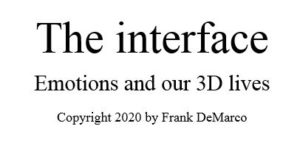
We aren’t going to discuss emotion and feeling for their own sake, nor to distinguish our ideas on the subject from those of your civilization, not that we could do that handily, there being so many schools of thought on the subject. And how would it help you if we were somehow able to do so? What you really need is a tying-in of concepts. How can you see your lives – how can you see Life – in such a way as to help you decide?
That has been our challenge here in 3D, hasn’t it? You’ve said we are here to decide what we want to be.
And that is true when seen from an individual point of view. But an individual point of view is always a partial point of view. The pinball’s idea of the purpose of a pinball game is not the same as that of the game as a whole, and neither view is the same as the person playing. You, living your 3D life, choosing, are the pinball. You as a non-3D bit of life participating in that 3D journey and in the conscious accompaniment of that journey are more like the player. And many non-3D intelligences each “operating” 3D lives and cooperating in 3D and non-3D for purposes beyond the ken of the pinball or the player are more like the game. Same reality but it looks different from different contexts or overviews.
So in this series we hope to tie in your experience of life, your greater (wider) understanding of the underpinnings of your life, and by implication a revaluing of it all.
Thus for example, our examination of feelings and emotions, etc., will not proceed in a vacuum, but will explicitly connect 3D life to its context. Life cannot be understood by isolating your examination to the 3D, which we regard as only a manifestation in an artificial environment of primary forces. Yet just this isolation is a continuing temptation when looking at nervous systems, endocrine levels, psychological stimuli, etc. We are not here to “correct” views of the 3D seen as itself; we are here to examine the 3D as part of its larger context, since that is the only way to make sense of it. Thus our discussion of physical technical terms and systems will (if we can bring it across) necessarily proceed from a starting-point unfamiliar even to those who live in both the metaphysical and the analytical-scientific worlds.
Rather than describing things as A or as B, either of which will be familiar to many, both of which will be familiar to some, we will describe them as A plus B, which is not the same thing.
A: Life seen in a greater context, 3D and non-3D
B: Life in 3D explained in isolation from non-3D.
A plus B: Life in overview (A) and in detail (B). The game, not just the player or the pinball.
So, let’s begin.
We will ignore the (fragmented) conventional wisdom and the received opinion. Neither the pinball nor the user is likely to define the game in the way a systems analyst would. We are into systems analysis here, not critiquing of the game or scoring the pinball. As Dion Fortune pointed out in an aside that grabbed you, the emerging science of psychology understood little, and what it did understand it had hold of from the wrong end, which falsified the knowledge for any practical purpose. Consciousness does not center in the individual, but in the totality. Life is not a bubble of consciousness surrounded by a sea of unconsciousness, but just the other way around. Once understand this (and apply it to what else you know) and your understanding of everything transforms.
The hierarchy is
Consciousness
Sub consciousness
Unconsciousness
Forget for the moment what is commonly thought or taught. Here is how we see it, and how we suggest it will profit you to at least tentatively see it.
The All-D – all of the non-3D world plus all of the 3D world – is consciousness. Life in 3D is constructed of consciousness, just as Paul Brunton said, though not quite in the way he saw it. Everything and all things; that is consciousness.
The human psychic life could be described as sub consciousness. 3D life is a state of limited consciousness, bounded by permeable but durable limitations proceeding from the 3D individual’s unawareness of its larger context. It is closer to a trance state than an active questing intelligence. If proceeds mostly by rote, according to rules that seem to it to be fixed and external. It is self-aware (to various degrees depending upon the particular individual, and also depending upon the time of day or state of life of the individual) but is only vaguely aware of its surroundings and is by definition unconscious of most of the underpinnings.
Unconsciousness is a relative term referring to all the things that the individual consciousness does not directly (that I, consciously) experience. Most of life, in short.
So, the sea of the unconscious is not a vast primordial soup into which 3D creatures can dip and make conscious. It is the entirety of the world unknown to the individual but itself quite conscious, quite ordered and creative, quite alive.
You see? We in a sense upend the way psychology sees things.
The universe (all that is) is conscious.
The human’s degree of consciousness is closer to a trance than to a real awareness of its place in things.
The human is unconscious of the vast world of 3D and non-3D that is beyond 3D comprehension or apprehension, but that vast world itself is quite conscious. Being unknown to the human consciousness, it is in effect unconscious.
These definitions and redefinitions will lead you on, if you allow them to. Nobody is asking anybody to ditch any previous understandings. Treat this and what follows as a mere “What if?” if it will help you go with it.